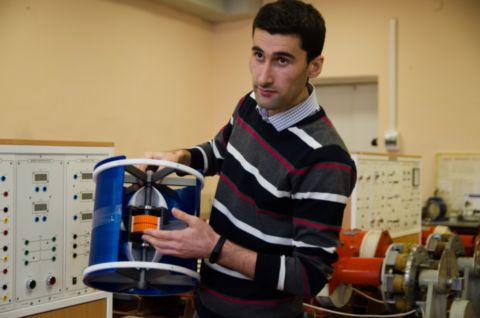South Ural State University cooperates with universities and educational organisations from all over the world: students actively participate in exchange programs, and new study programs are being opened. While working on his dissertation, a SUSU international student created a project for a miniature hydropower plant (HPP), which can be used for small rivers. This is a very relevant topic for the Republic of Tajikistan, which has large hydropower resources.
Currently, students from Tajikistan are studying in all of the programmes available at SUSU: Bachelor’s, Master’s degree, and postgraduate programmes. In November, postgraduate students from Tajikistan successfully defended their dissertations in the Department of Electrical Engineering.
Dilshod Aminov, the Department’s postgraduate student, dedicated his dissertation to the basics of developing water-submersible hydrogenerators to be used as renewable energy sources for small and medium rivers. We asked him to tell us about his work.
─ How relevant is the topic of your research?
─ My dissertation was devoted to the use of hydro resources of small and medium rivers. According to estimates by experts, this resource is several times larger than the energy of large rivers but is practically unused. Large hydroelectric power plants are being constructed in Russia and around the world as these resources are running out. The era of development of small rivers is beginning. Environmental requirements, to a large extent, complicate the development of small hydropower plants. We know that modern hydropower plants, especially dam-type plants, significantly change the surrounding landscape and the environmental situation. In our work we tried to solve these problems. Our mini hydropower plant is completely submerged in water and cannot be seen. It uses the river's natural water flow. This solution allowed us to preserve nature and not disturb the appearance of the surrounding landscape, which is very important. But it is very difficult to make a reliable electric machine to operate within a body of water. We had to fill the inner cavity of the generator with a special oil, apply pressure compensators and other technical solutions. All these innovations were included in the construction of our designed system.
─ What novel approaches were used in your work?
─ We used a non-traditional solution in our work. Small rivers vary greatly in their characteristics. They differ by their topography, size, and speed of flow. We decided not to pursue a standardized mini-HPP, because standardized generators will not work optimally due to the unique characteristics of each river. We decided to develop individual mini-HPPs for each river and specific area of installation. Modern flexible manufacturing allows us to make this concept a reality. But we had to develop a system to engineer such hydrogenerators. My dissertation was dedicated to this issue.

─ How effectively was the project managed?
─ Our work was carried out in the Department of Electrical Engineering. It was quite a big project which involved the participation of the Department staff. The work was supervised by Department Head, Doctor of Sciences (Engineering), Sergey Gandzha. He was also my scientific advisor. Of course, the groundwork for this difficult topic had been completed in the Department: the optimization of electric machines, the electromagnetic and thermal analysis of electromechanical devices. But the system itself had to be developed from a blank slate. Clear organization of the research, proper determination of the concept, the use of the newest engineering technologies to achieve our goal—all of these are the merits of my supervisor. I myself had to solve many creative tasks to engineer this system, but my actions were supervised by experienced professors and my scientific advisor. I would like to express my gratitude to them.
─ What difficulties did you have to overcome when working on your dissertation?
─ It was quite difficult to perform such a large volume of work, but interesting. We had to master CAE systems (software which allows you to evaluate how a computer model of an object will behave in real operating conditions – ed. note), the foundation of which is the finite element method. This includes programs for electromagnetic analysis, thermal analysis, and three dimensional solid-state modelling. I was able to create my hydrogenator and check all of our engineering solutions on a model, but this was a plastic scale model created on a 3D printer.
─ Is the work experience you gained at SUSU valuable to you?
─ Of course. I will return to the Institute of Energy of Tajikistan with a huge amount of experience in conducting difficult research, with new skills in working with modern software. This is very serious training. I would like to take this opportunity to thank the administration of the university, and personally—Aleksandr Shestakov, for providing all of the necessary conditions for completing this difficult research; in particular, I had the opportunity to work on the university’s supercomputer and use expensive licensed software.
South Ural State University is developing its partnership with universities in Tajikistan and two-way exchange of students and teaching staff. The priorities of our university’s work with Tajikistan include cooperation in scientific fields of mutual interest; improving the scientific qualifications of Master’s degree students, doctoral students, and the teaching staff; exchanging knowledge on the development of breakthrough teaching methods; exchanging leading research publications and materials; organizing joint symposiums, conferences, and seminars; and the joint execution of projects and programs.




